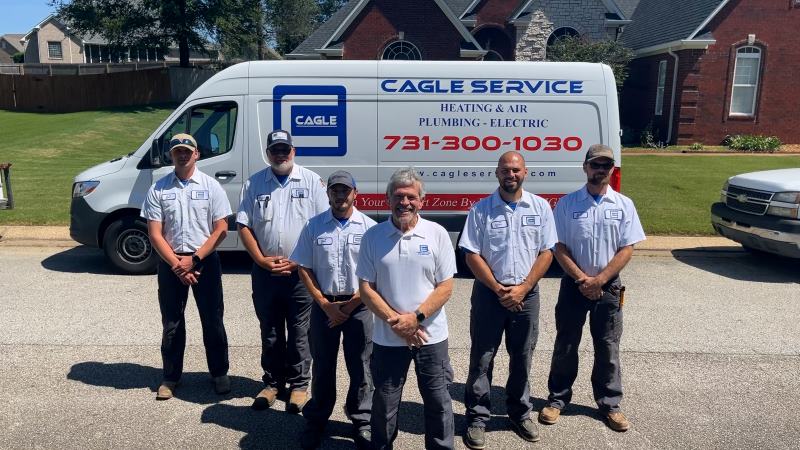At Cagle Service Heating and Air, we spend a lot of time sharing helpful information on how to save energy when it comes to our heating and air systems. We do this for a good reason. For most of us, our heating and air conditioning expenses make up the largest portion of our utility bills. So why not try to save in this area with strategies such as reducing our heating costs?
But how do you reduce your heating costs?
Some of the most effective solutions are improving insulation, reducing drafts, increasing the efficiency of your heating system, and lastly, adjusting the thermostat. Now that we’ve answered the question, let’s get into a little more detail for each solution.
Improving the Insulation
The most foundational solution for cutting into your heating bill is to evaluate and improve the insulation where necessary. Insulation is meant to keep the indoor heat within the home and to keep the outside cold air from entering. This will also improve your cooling system’s effectiveness as well.
But how do you evaluate which areas need improved insulation? Great question!
Evaluation Methods
The easiest and most obvious method to find poorly insulated areas is to simply walk around your house, especially near the outer walls. When you find areas that seem to be cooler than the rest of the room, then you’ve probably found a poorly insulated area that is driving your heating bill up. The cause can also be a draft that needs to be sealed. We will get into draft reduction in more detail in the next section. You can also feel along the walls. If you feel sections that are cold and not as warm as the rest, the insulation in those areas is likely the issue. If you find suspect areas, you can confirm your suspicion by safely removing an electrical outlet in that area and inspecting the insulation. You can see what kind of insulation is installed and how thick it is.
When it comes to the attic space, EnergyStar has a great guide on how to evaluate and determine what needs to be done per your specific situation. For example, for our area of Jackson TN, our attic insulation depth should be anywhere from 9 inches to 24 inches depending on the material and desired level of insulation.
Another evaluation method consists of using tools such as a laser thermometer or thermal imagery. A laser thermometer can determine the temperature of walls and ceiling spaces. This will allow you to pinpoint areas that are cooler due to a lack of insulation. Similarly, thermal imagery actually displays cold spots which can highlight areas of your home that are colder than others and allow you to further investigate the cause. These areas include cold spots in rooms, drafts around windows and doors, and poor insulation inside the walls and ceiling.
Lastly, there is always the option to call out a professional to evaluate the insulation of your home. This is the most costly option, but if you don’t feel comfortable performing any of the methods listed above, it’s a surefire way to determine the state of your current insulation.
Once you find poorly insulated sections that need to be improved, then you can begin exploring the improvement methods. These methods can be done yourself or you can hire a professional. As you improve the insulation of your home, you will notice a decrease in your heating bill because your heating system isn’t running as long as it was before.
Draft Reduction
Closely related to poor insulation, drafts can also be a culprit of high energy bills. Therefore, reducing drafts is another effective method for keeping the cold air outside and the warm air inside. Drafts are simply areas that aren’t sealed properly that allow outside air into the home. Some of the most common areas for drafts are exterior doors (front door, back door, etc.), window frames, fireplace dampers/flues, attic hatches and even electrical outlets.
There are numerous methods for detecting drafts. The easiest and most practical is simply doing a visual inspection. Look for areas that have cracks and gaps that lead to the outside environment. If you can see daylight, it’s likely that you have found a draft source. This method also works with shining a flashlight on suspect areas at night. If you see light coming through on the other side, you’ve found a draft source. Similarly to the method for finding poor insulated areas, you can feel for cold air coming through any suspect areas. And lastly, thermal imagery with a thermal leak detector is an option as well. Just like with the poor insulated method listed above, thermal imagery will also show you where cold air is entering the home through drafts.
If you’d rather pay someone else, or if you are having trouble, you can have a professional come out and inspect your home. They can perform an energy audit and perform tests such as a blower door test. A blower door test depressurizes the home and is an excellent method for finding leaks. This will usually include an inspection of the state of the insulation as well.
Caulk or weatherstripping will usually be the solution for sealing any drafty areas, although sometimes spray foam or something more extreme is needed.
Increasing the Efficiency of Your Heating System
If your heating system is more than 10 years old then it’s likely not nearly as efficient as the systems of today. Furnaces today are up to 98.5% efficient. The system’s AFUE rating determines the efficiency of the system, whether it’s a furnace, heat pump, or boiler. The more efficient the heating system is, the more fuel is optimized during the heating process. The less efficient, the more fuel is wasted during the heating process. For example, a furnace with an AFUE rating of 80% uses 80% of the fuel and the rest is wasted. You could say the more efficient a system is, the more well spent the money is for the heating bill.
Let’s say you have a 10 year old furnace. While replacing your furnace with a more efficient model will cost money upfront, it will likely pay itself off within it’s lifetime and in the meantime reduce your heating bill. Upgrading to a high-efficiency furnace can save up to 20-40% on your heating bill!
Related: How Much Can a High Efficiency Furnace Save?
Adjusting the Thermostat
Adjusting the thermostat can seem pretty simple but it’s often overlooked. And if you aren’t wanting to spend money or much time in order to reduce your heating bill, this is a great option. Every 1 degree adjustment on your thermostat typically equates to 1% of savings.
So one option is to start by lowering the temperature of the thermostat when everyone is out of the house. You can lower it to as low as 50 degrees F when the house is vacant. Another option is to lower the temperature when everyone is asleep. If you, and everyone else, can be comfortable with a 5-10 degree drop in temperature while sleeping, then you can begin to experience some extra savings on your heating bill. It’s recommended to leave the temperature at the lower temperature for at least an 8 hour period to really make it worth while.
Lastly, if you and everyone else in your home can be comfortable with a reduction in temperature on a more permanent basis, go ahead and lower your default set temperature. All of these strategies in combination can really create some savings without any cost financially. You might have to wear an extra layer of clothing though!
If you are willing to spend a little money, a programmable thermostat can really make it a lot easier when it comes to managing the thermostat’s temperature. Instead of having to adjust the thermostat every time manually, a programmable thermostat will do it for you automatically.
Related: Winter Thermostat Setting to Save Money
We hope these tips have helped you on your journey to reducing your heating bill costs! What has been your experience so far? Do you have any tips to add?
Feel free to comment below. We’d love to hear from you!



